-
TRW-F
TREE RESCUE WORKSHOP - FIREFIGHTER
(See Current RTR Open Enrollment Schedule for when/where this program is offered) Read (or print) the most rcent color information flyer for this workshop HERE
Why is this the Tree Rescue Workshop-Firefighter needed? And better yet, WHY Now?
Trees present difficult rescue solutions as they are a foreign environment to emergency personnel. In a way, they are very much like tower rescue in that they begin at the bottom with the victim or casualty high up in the branches. How can a firefighter gain access from the ground to this elevated location and get the person needing rescue down? Even better than that, how can this be done safely and in a timely fashion? These are the basic components of the Tree Rescue Workshop— Firefighter.
For power delivery utilities, Reed has always warned that linemen should be the first to get a fellow injured lineman down from a tower. If the fire department takes over that incident, it will take many times longer as the emergency agencies need to have safeties in place to access a power line. With trees, it is much the same. An arborist is the first line rescuer of a co-worker up in a tree, as well they should be. But often, the fire department is called because there is a breakdown in the rescue effort or there is no-one to perform it. Hence, the fire services need to have training on how to approach these difficult bottom up rescues short of using an aerial platform or ladder.
The TRW-F is a rescue class for fire and emergency services—not for arborists. We employ techniques, rope and equipment that would be found on a special operations rescue truck.
NOTE: Limited personal skills other than the first 8 uses of the AZTEK. For personal skills see Personal Skills Rescue Workshop or Rope Access Skills Workshop 1 & 2
The RTR Instructors: Keith & Reed Thorne
Keith Thorne main occupation: ARBORIST. (Mick’s Tree Service, Flagstaff, AZ)
Keith is Reed and Jayne Thorne's middle son (born 1990). He is a regular assistant co-instructor with his father, Reed, and travels extensively around the United States, Canada, Australia, England/Scotland, Japan and anyplace else were he can assist in rope rescue or rigging classes for Ropes That Rescue. Known as a true critical thinker, he prides his ability to think outside the box with the students. With tree work, Keith brings the understanding he has attained from years of rope access and rescue rigging and understanding of physics to the arborist world. When dealing with trees where limbs are often not strong, this knowledge is crucial for a tree rescue workshop of this kind. That is why there is so much information in this seven day TRW-F.
Keith’s Professional Accomplishments:
Keith has also certified as a rope access technician supervisor Level 3 with the Society of Professional Rope Access Technicians (SPRAT) and has supervised rope access jobs on wind turbines, bridges and hydroelectric dams throughout the USA for Abseilon in Phoenix. Keith has also worked both in Saudi Arabia for Arabian Rope Services and in Queensland, Australia with Rob Stringer and his rope access company, Highpoint Access and Rescue.
In 2020, Keith competed with two friends (Both RTR alumni) in the North American Petzl North American ROPE TRIP in Salt Lake City, Utah where they took first place honors for Abseilon. They were slated to then compete in the 2021 Petzl Rope Trip World Championships in Singapore but that was unfortunately cancelled due to the worldwide pandemic.
Senior Lead Instructor, Reed Thorne, will also be assisting with this program.
From Kevin Yates, Florida
For years my fellow fire fighters in Central Florida have discussed the need for training specifically on rescuing tree workers in trouble. The challenge was finding instruction familiar with rope rescue and industrial arbor care. Tree care emergencies are the most common high angle rescue incidents encountered in our fire department and victims are sometimes beyond the reach of our ladders. When RTR announced the class I knew I had to take it. I was excited to be a part of the very first class and it delivered well beyond my expectations. There is nothing else in the first responder training world that comes close to this class. We were challenged with a wealth of information regarding the arbor care industry. We experienced enough hands on hours learning tree access techniques to make me very confident in my ability to reach victims rapidly. Additionally, we practiced a variety of rescue options. The class was mentally and physically challenging… and I would do it again tomorrow. Thank you Keith and Reed. I highly recommend this to anyone wishing to adapt rope rescue and access to urban or rural tree canopies.
From Philip Steele, Chico Fire (CA)
To say that my colleagues and I completed the RTR Tree Rescue Workshop with a sense of awe and respect for technical tree rescues is an understatement. Our fire department identified tree rescues as a high-risk, low frequency event, however we were not aware of any fire department specific rescue training until RTR offered such a program.
Keith and Reed have obviously spent a lot of time utilizing their combined, unique experiences and expertise to develop a comprehensive bottom-up tree rescue curriculum. Furthermore, the professionalism of both instructors was on full display as they broke down complex principles to a firefighter’s level, promoted safety and provided patient assistance to students.
The Tree Rescue Workshop exceeded our expectations, humbled our rescue skills and left us with a sense of needing to motivate ourselves, and our team, to get better. We also appreciated the emphasis on teamwork and cooperation with other Workshop attendees, which made our experience very enjoyable despite some long, physically demanding and mentally challenging days. The equipment required to attend the workshop was an eye opener to us, as we saw firsthand how having the correct equipment made operations much less complicated and less physically demanding. The scope of rescue options presented in the course was amazing, and really forced us to work outside of our normal comfort zone and paradigms. This was especially true when we used the “Sheppard’s Hook” to gain access to elevated positions within the tree, techniques in spur climbing and limb walking tested our fortitude, thinking and physical abilities.
It was a joy to be in Nevada City for a week and we were grateful that our kind hosts Arianna, Shaun and Nakomi shared their beautiful property with us. My colleagues and I want to offer our sincerest thanks to Keith and Reed for developing such a worthy course and maintaining the highest standards in professionalism and rescue knotcraft.
Philip Stelle
City of Chico Fire Department
From Darerell Coates, Seminole County Fire, Florida Keith and Reed,
I wanted to take a few moments and share with you both about how grateful I am to have had the opportunity to attend your recent Tree-Rescue Workshop. As you both are aware, I’ve been involved in the fire-rescue service for over three decades. During that time, my department has had multiple calls for service which have involved either an arborist(s) or civilian(s) requiring rescue from a tree.
There’s a saying that I’ve come to embrace throughout my career – “Amat Victoria Curam”
(Victory loves preparation). Unfortunately, the fire-rescue profession requires one to be appropriately prepared for so many things; however, not all things are anticipated. And those usually reveal themselves as the unforeseen events. These types of rescue situations typically present themselves as an afterthought until they happen. Often bringing about a newfound awareness of existence and enticing one to take them serious enough by adding them to the list of potential rescue calls. And if we’re hoping for chance to favor the prepared mind. We, as rescuers, suitably have to procure the knowledge, ability, and training for such incidents. The only caveat to that successful endeavor is finding the aforementioned.
To our enticement, we began our quest to seek out a rescue-based program in an arborist type of environment. Needless to say, we weren’t very successful in locating one. And trying to reach out to arborist companies for help is very difficult because they’re either too busy or not openly interested in training with fire departments. Therefore, you could image our excitement when we’ve noticed that RTR was providing a Tree-Rescue course for emergency responders (Firefighters). We knew our search was over. Not only did we find something that appeared rather elusive in nature…we’ve found a highly, reputable and notably experienced company that we’ve come know and truly trust to do so – RTR!
The TRW was absolutely fascinating and totally on point for what one needs to utilize in effecting rescues in an arborist type of environment. The significant information and relevant techniques provided within the course are very applicable for professional rescuers; moreover, they’re openly what any rescuer should have to perform successfully during tree-based rescues. I must profess that I have a new-found respect for and a better understanding what arborist do for an arduous and risky living! That not only opened my eyes, but my mind on the severity of such rescue situations.
In closing, to truly define my appreciation for this class in so many words are rather challenging for me since there are numerous notions of gratitude to express. But I will try to keep it all within the realm of brevity. First, I can’t say enough on how this class will benefit all professional rescuers in being more prepared for tree-based rescue incidents. Secondly, the practical rescue skills and techniques that are taught will definitely enhance one’s abilities to confidently perform amid such rescue environments. Lastly, the level of knowledge and experience you’ve both brought to the table during this program will remain undoubtedly invaluable for firefighters providing technical rescues. Then again, my professional colleagues and I didn’t expect anything less from an RTR program. It’s what we’ve come to respectfully know from a company with individuals like yourselves – Thank you both!
Darrell Coates, Lieutenant
Seminole County Fire Department
-
TRW-F Key Points
TRW-F KEY Points:
Read (or print) the most rcent color information flyer for this workshop HERE
- Assessment of the tree rescue incident
- Fundamentals of tree risk assessment (So the rescuer can act decisively in the knowledge of this seemingly foreign environment)
- Understanding of standard tree industry rigging and access methods (To better understand the rigging you’ll encounter, and best be able to leverage it to your advantage)
- Knot and anchor systems used in tree access and rescue, as well as critical knowledge in mechanical advantage systems and force vector analyses (To give you all the mental tools you’ll need for success in tree rescue)
- Rescue archetypes
- Tree-based (Rescue climber(s) needed only)
- Ground-based (No rescue climber needed, ground operations required)
- Combination (Tree and ground-based)
- Tree access methods and movement within the canopy
- Throw lines
- Double and single rope techniques
- Incrementally advancing doubled rope
- Advance-placed shepherd’s hook
- Spikes + flip lines
- Hitch-based aid climbing
- Existing systems (victims’s climb line & industry rigging equipment)
- Limb walking, and horizontal movement within the canopy
- Using existing pre-existing equipment for rescue
- Anchors, friction devices, high points, ropes
- Special scenarios
- Entrapment, stabilization, cutting, or lifting scenario
- High Voltage power lines
- Victim without harness
- Much, much more….
-
TRW-F Details
7 Days - 8 hours per day in length 10 Students (or more with second RTR instructor)Difficult to extremely difficult - Some tree climbingClassroom 20%, Practicals 80%Read (or print) the most rcent color information flyer for this workshop HERE
Prerequisites: None (Prior rope rigging experience strongly recommended)
Get: RTR Application
Go to: Registration Information
Find out tuition and when and where offered: See Schedule -
TRW-F Photos
TREE RESCUE WORKSHOP-FIREFIGHTER PHOTOSFrom Ropes That Recue collection. All photos copyright RTR ©1999/2022Read (or print) the most rcent color information flyer for this workshop HERE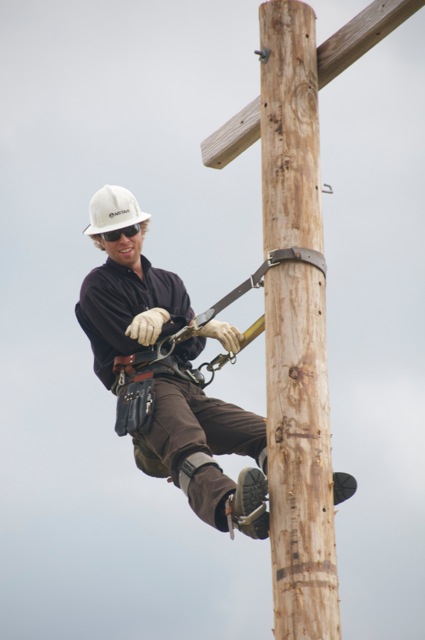
TRW-F Lead Instructor, Keith Thörne, climbing utility pole at NSTAR Electric during RTR workshop with his father, Reed, for linemen 2014 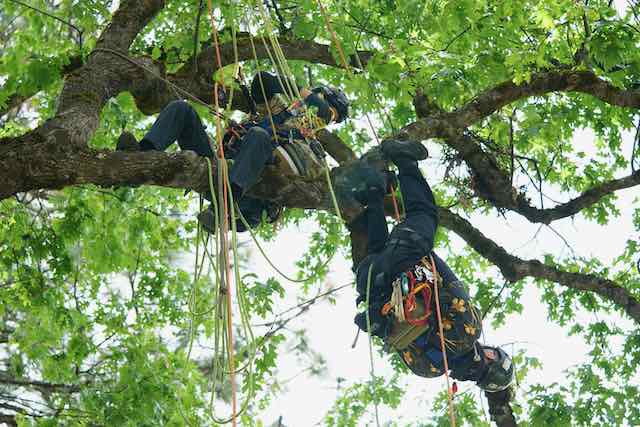
Photo 1: Students learning limb walking and limb rescue in a huge live oak. Photo by Keith Thorne. 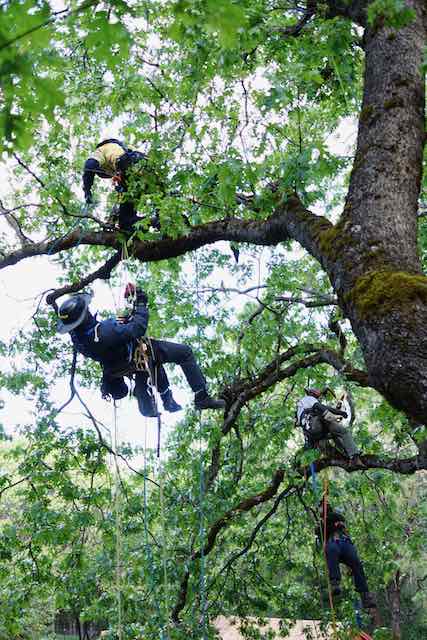
Photo 2: Students learning limb walking and limb rescue in a huge live oak. Photo by Keith Thorne.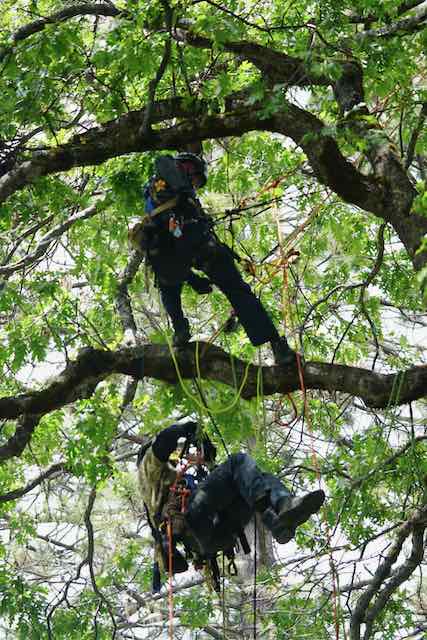
Photo 3: Students learning limb walking and limb rescue in a huge live oak. Photo by Keith Thorne. 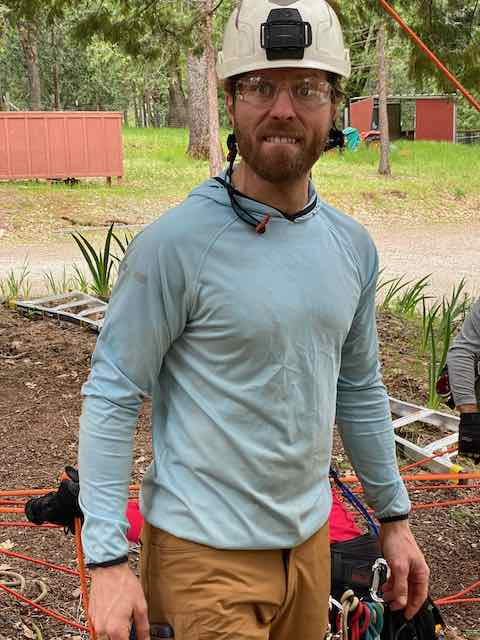
Keith is the Lead Instructor for the Tree Rescue Workshop. Reed is his assistant insutructor.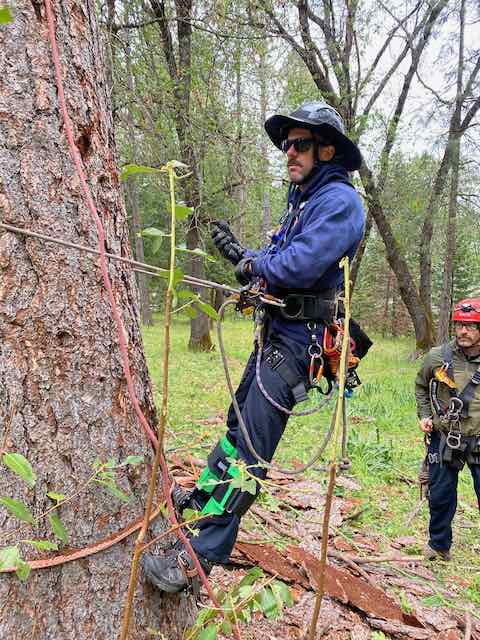
Matt Jaynes of Florida getting ready to gaff (spike) up a limbed Ponderosa in the Nevada City TRW-F 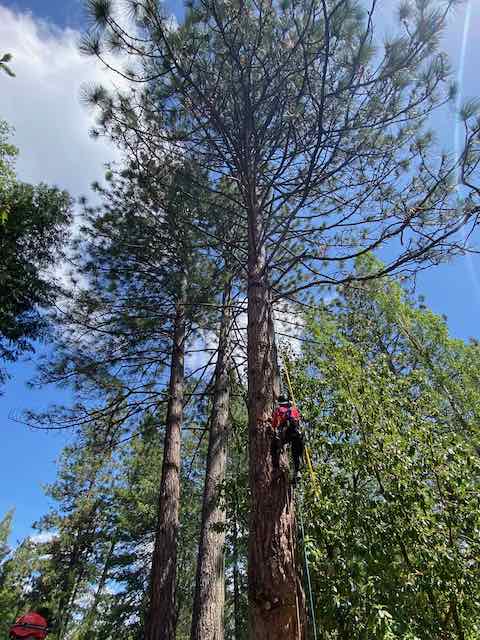
Advance-placed fall protection using a long shpherds hook 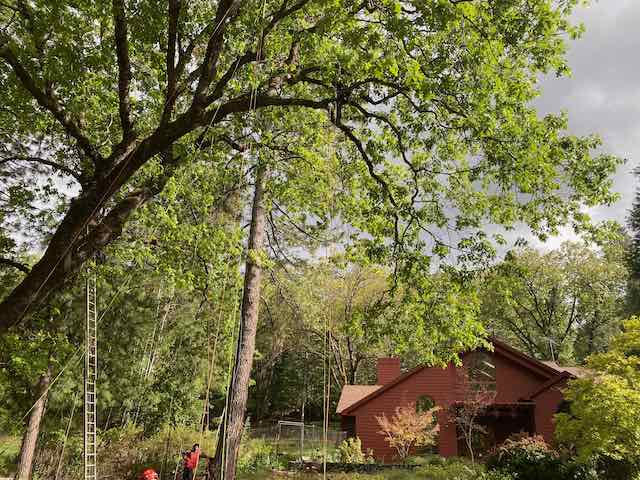
The live oak "playground" in the front yard of Arianna and Shaun Thorne. See student on the limb above.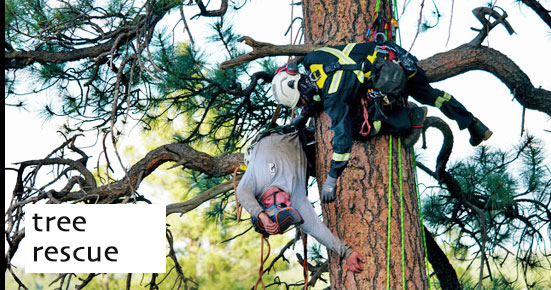
Keith perfoming tree rescue of injured arborist in Flagstaff, AZ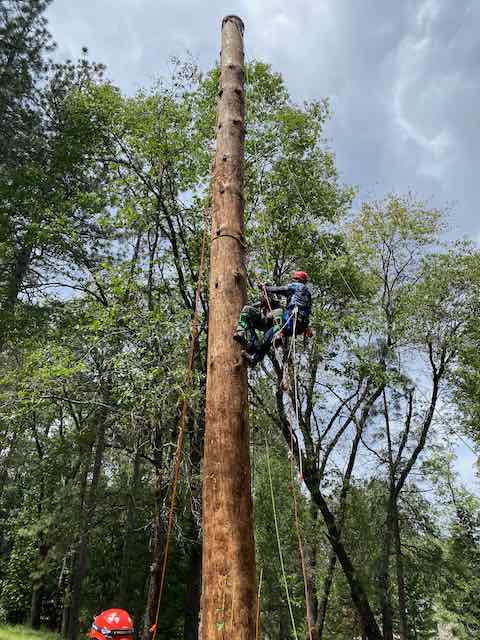
Our limbed Ponderosa tree in the front yard of the Thorne residence. It was perfect for showing students how to rescue from a topped tree with very little room above if the arborist is injured there.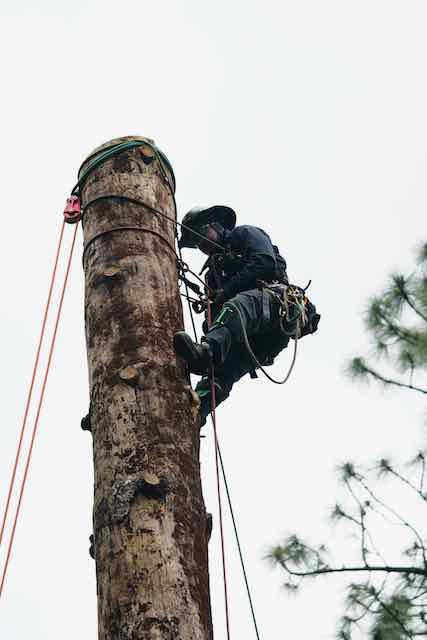
At the top of the limbed Pondeerosa.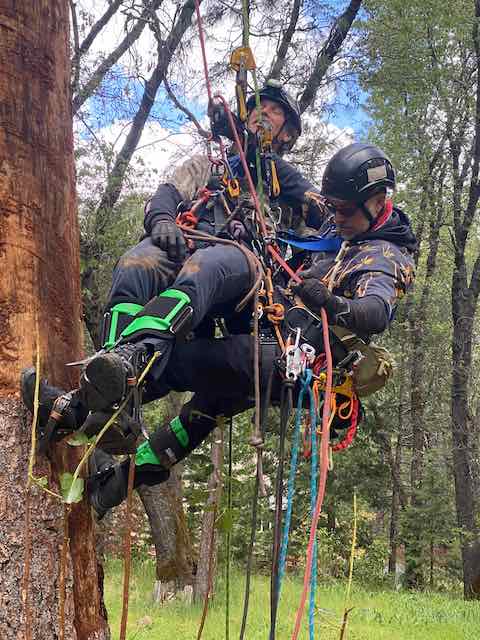
Kevin Yate had rescued Darrell Coates from the limbed Ponderosa tree.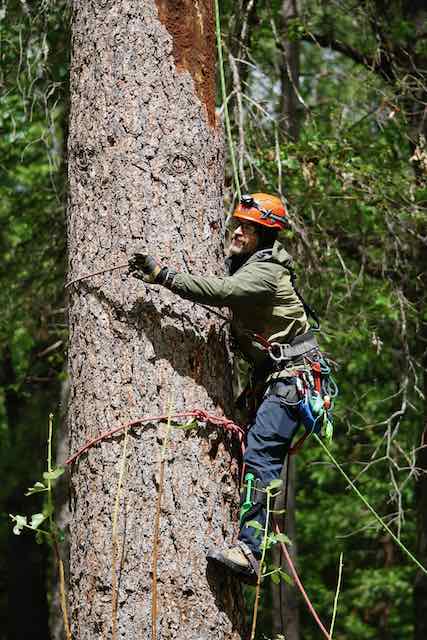
Students learn how to ascend a large tree with two safties.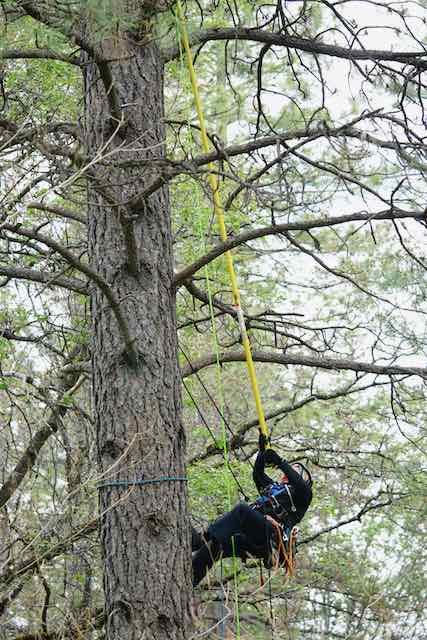
Advance-placed fall protection using a long shpherds hook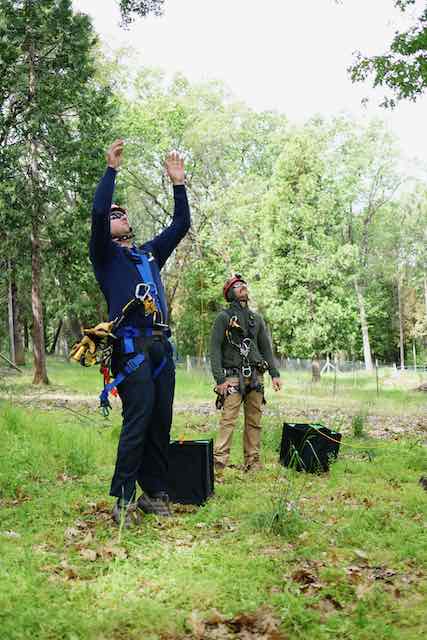
Students learning line throwing techniques. The key to successful tree rescue.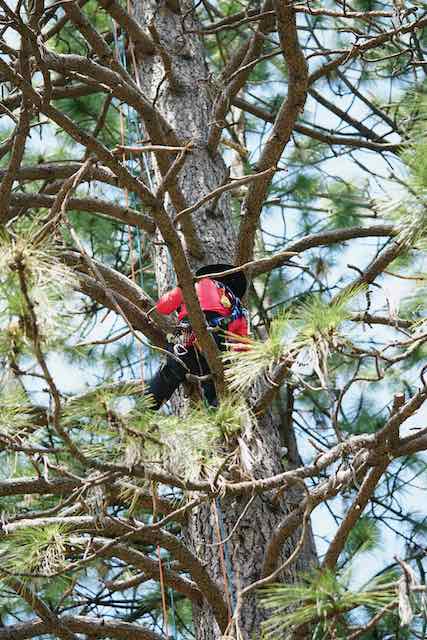
Limb climbing.
Below: Students in the first ever RTR Tree Rescue Workshop-FF enjoy a warming fire and debrief after the long arduous program. It is Hawaiian Shirt Day and extremely cold at the Thorne residence in Nevada City, California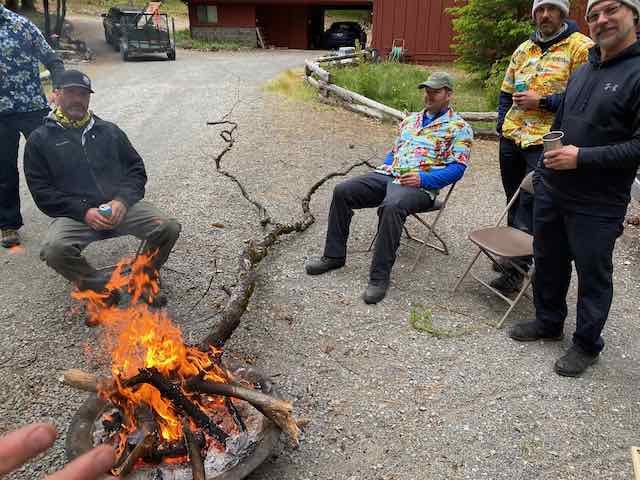
-
TRW-F Equipment List

